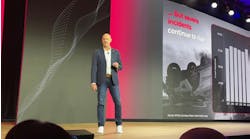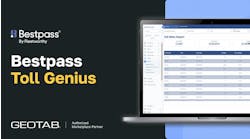Many years ago, Volvo set down the words behind the company's focus on safety: "Automobiles are driven by people." Yet now, safety is a big part of the push to go driverless, and commercial vehicles may lead the way. When people aren't the ones driving anymore, what will vehicles be?
That was the question posed in the "Essence of Autonomy" contest held by Local Motors, which Fleet Owner followed as the company unveiled a 3D-printed urban transit vehicle over the summer. Last week, Mouser Electronics and Local showcased a design by contest winner Finn Yonkers of what a vehicle could be or do when that central part of the concept — a person steering the thing — is no longer necessary full-time.
There's still a steering wheel, so the design didn't go as far as it might have. This latest take on autonomous vehicles mirrored a function now being tested in commercial vehicles, but with a different purpose. A drone the vehicle carries can be launched and provides an aerial view of the surroundings — so rather than having to just drive by a place, the idea is that people can see and experience it more.
"You're actually taking the notion of driving and the sensory experience that you have when you travel through space and amplifying that rather than reducing it," Yonkers says of his design in an interview with engineer Grant Imahara.
Medium-duty truck OEM Workhorse has been testing drone pairing with vehicles this year to deliver packages. The company's E-Gen hybrid electric truck can launch an octocopter drone carrying parcels weighing up to 10 lbs. up to 2 mi. away, which the truck's driver monitors as it drops the package at someone's doorstep.
Otto, an autonomous vehicle developer, had a person watching from the sleeper berth while the company's self-driving truck completed its first commercial delivery last month. Otto's autonomous tractor-trailer brought a load of Budweiser beer 120 mi. from Fort Collins to Colorado Springs, CO. The company predicted that in the transition to self-driving trucks, autonomous operation on certain stretches of highway will allow truck drivers to rest in the sleeper — if people can get past letting the machine totally have control, that is.
"By embracing this technology, both [Otto and Anheuser-Busch] are actively contributing to the creation of a safer and more efficient transportation network," said Otto co-founder Lior Ron at the delivery's completion.
Business and market consultancy ABI Research has suggested that head-up displays and augmented reality technology, which are making more inroads in premium automotive applications, and advanced safety/ anti-collision systems will be bridge technologies to autonomous vehicles. Those systems today clearly target assisting the driver, and that could be the turning point: the technology that helps you drive now could someday fully take control.
Smartphones a key?
What else might enable the transition to that fully self-driving vehicle future? Kelly Frey, vice president of product marketing at Telogis, A Verizon Company, notes that a common and potentially portable interface might be necessary — and that could take the form of the increasingly ubiquitous smartphone.
"It's not too hard to fast-forward a little and think to the future with autonomous vehicles," he tells Fleet Owner. "Apple, Android and Google are making a big bet that the interface that you have with your vehicle is going to probably be controlled by one of them."
"So in the future, I'm sitting here in my office and I want to go home. It's not too hard to imagine that I'd be able to just pick up my smartphone and get my car — or a pooled car — to come out of the parking garage and come to the front of the building," he continues.
Rather than a BMW, Ford, Chevrolet, Mercedes-Benz or some other specific OEM interface, Frey suggests that autonomous vehicles may incorporate a common user interface that would identify the driver and all related functions and preferences. That would include everything from favorite radio stations to home address and points of interest or destinations.
"It probably will be one of them — Apple, Google, Android — that's going to control that. It'd be an open system that would allow access to literally hundreds of thousands of developers who are trying to offer the best experience for that vehicle," Frey contends.
That's also a possible next step in the commercial truck technology realm, he adds. In terms of design cycles, smartphones and their accompanying apps and systems are almost constantly refreshed and replaced, so their integration in controlling more autonomous cars and trucks could make for much faster related equipment advancements and updates.




